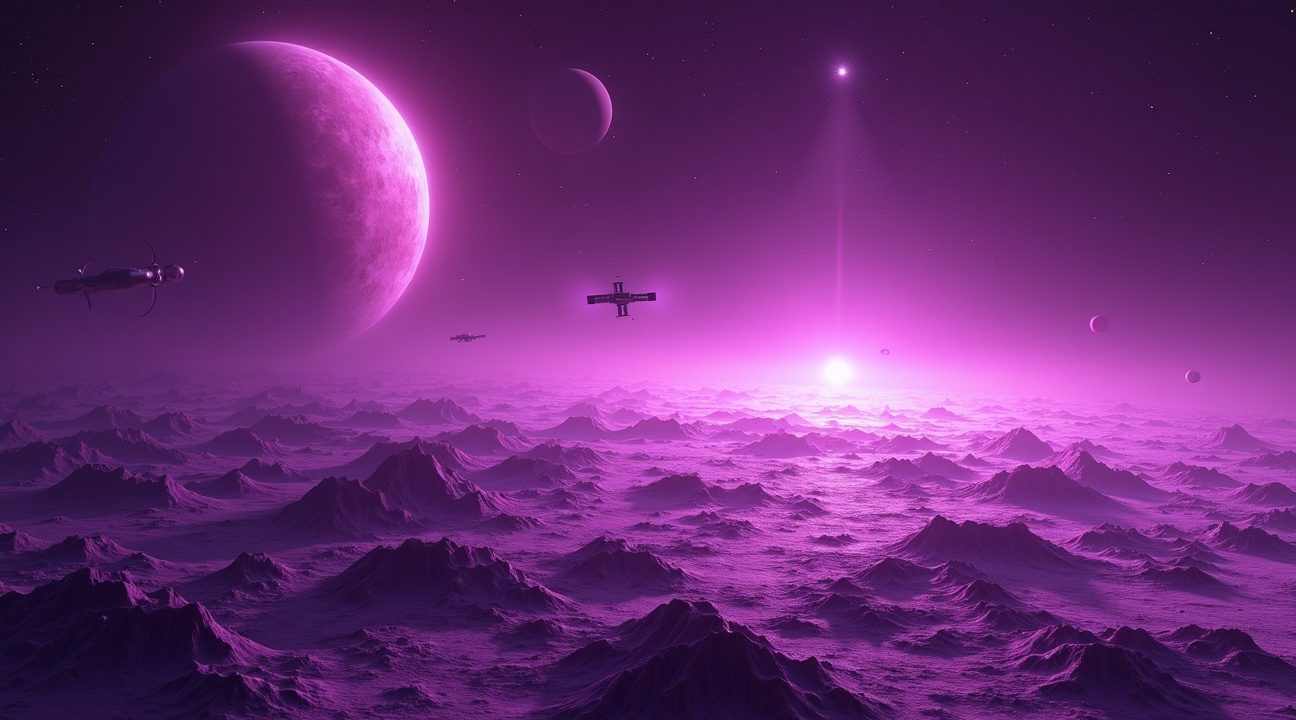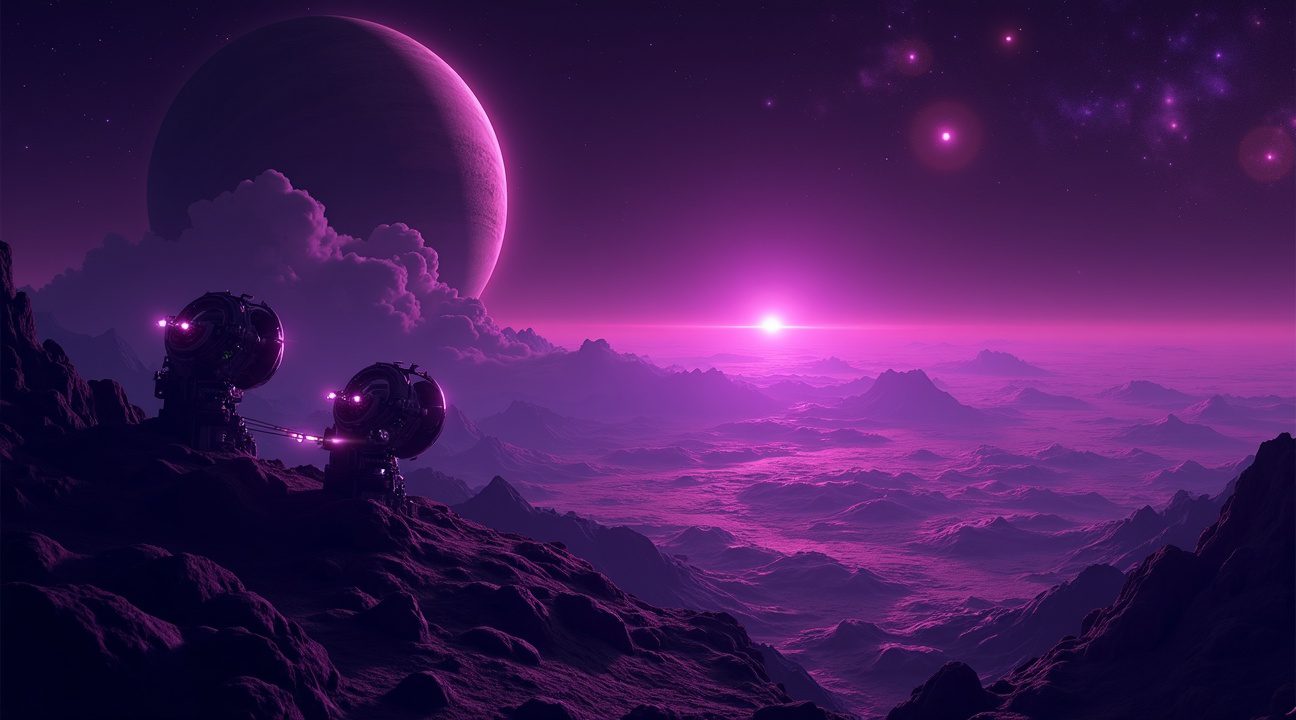Recent scientific research has upended the assumption that alien life would visually resemble Earth’s green vegetation, suggesting instead that extraterrestrial organisms might appear purple due to an entirely different form of photosynthesis.
Revolutionizing the Perception of Alien Life
Researchers are now exploring the possibility that retinal-based photosynthesis, found in ancient purple bacteria, could be a more common biochemical pathway on other planets. Unlike Earth’s flora that relies on chlorophyll, this alternative system uses retinal pigments to capture light, potentially making such lifeforms more adaptable in alien environments—especially those orbiting red dwarf stars.
Key Takeaways
- Pigment Differences: Purple bacteria utilize retinal-based pigments that absorb different wavelengths, efficiently harnessing energy that green chlorophyll-based life cannot utilize.
- Ancient Origins: Evidence suggests that Earth’s earliest life may have been dominated by purple organisms before the rise of chlorophyll photosynthesis during the Great Oxygenation Event over 2.4 billion years ago.
- Environmental Adaptation: These organisms are adapted to low-light, low-oxygen habitats by absorbing infrared or red light—ideal traits for life situated on planets with limited sunlight or different atmospheric compositions.
- New Biosignature Strategies: Traditional biosignature detection focuses on chlorophyll’s green spectral signature, but retinal pigments leave distinct spectral fingerprints that may be visible through advanced astronomical observation.
- Technological Challenges: While current telescope systems struggle to detect subtle surface color variations on distant worlds, astronomers are developing next-generation instruments with superior spectroscopic precision to differentiate biological purple signatures from geological or chemical phenomena.
This paradigm shift encourages scientists to broaden the scope of potential biosignatures in the search for alien life, making retinal-based photosynthesis an exciting focal point in astrobiology.
Alien Life Could Be Purple, Not Green, According to New Research
Recent scientific research has challenged the long-held assumption that alien life would present as green, much like Earth’s vegetation. Instead, researchers propose that extraterrestrial surface life might actually appear purple, fundamentally shifting how scientists approach the search for biosignatures on distant worlds.
Purple Bacteria and Alternative Photosynthesis
The foundation of this purple alien theory rests on the prevalence of purple bacteria found right here on Earth. These organisms utilize retinal-based pigments instead of the chlorophyll that gives plants their characteristic green color. Purple bacteria represent one of the most ancient forms of life on our planet, suggesting they could be equally common or even dominant on other worlds with different environmental conditions.
Scientists have discovered that these purple organisms can thrive in environments where traditional green photosynthesis struggles. They efficiently capture light wavelengths that chlorophyll-based life cannot use effectively, making them potentially better adapted to planets orbiting different types of stars. This adaptability suggests that alien life forms might favor purple pigmentation over green in various cosmic environments.
Detecting Purple Biosignatures
The implications for exoplanet research are significant. Current biosignature detection methods primarily focus on identifying the spectroscopic fingerprint of chlorophyll-based photosynthesis. However, purple pigments create distinctly different signatures when analyzed through astronomical instruments, producing unique wavelength absorption patterns that scientists can detect from vast distances.
This discovery means researchers must expand their search parameters beyond traditional green biosignatures. Purple surface life would reflect and absorb light differently than Earth’s vegetation, creating observable color fingerprints that space-based telescopes could identify. The retinal-based pigments in purple bacteria absorb light across different portions of the electromagnetic spectrum, potentially making them more visible to our detection equipment than previously assumed.
Understanding these alternative biosignatures becomes crucial as scientists examine potentially habitable exoplanets. Many of these distant worlds orbit red dwarf stars, which emit different light wavelengths than our Sun. Purple bacteria might actually be better suited to these conditions, making purple biosignatures more likely discoveries than green ones.
This research connects with broader investigations into extraterrestrial life, including studies suggesting that aliens might already exist in forms we haven’t recognized. By expanding the color palette of potential alien life, scientists increase their chances of successful detection and identification of living worlds beyond our solar system.

How Purple Life Could Have Dominated Early Earth Before Green Plants
I find it fascinating that Earth’s earliest life forms might have painted our planet in shades of purple rather than the familiar green we see today. Before the emergence of chlorophyll-based photosynthesis, purple-pigmented molecules called retinal likely powered the first energy-generating reactions on our planet.
The Purple Earth Hypothesis
Retinal molecules operate differently from chlorophyll, absorbing green and yellow wavelengths of light while reflecting and transmitting red and blue portions of the spectrum. This unique absorption pattern would have created surface environments dominated by purple hues across early Earth’s landscape. I can envision vast microbial mats and primitive organisms displaying vibrant purple coloration as they harnessed solar energy through retinal-based systems.
These ancient purple organisms represented a completely different approach to photosynthesis than what eventually became dominant. While modern plants use chlorophyll to capture red and blue light, reflecting green wavelengths, retinal-based life forms captured the middle portions of the visible spectrum. This complementary relationship suggests both systems could have coexisted, with purple life potentially filling ecological niches that green photosynthesis couldn’t exploit as effectively.
The Green Revolution
Everything changed approximately 2.4 billion years ago during the Great Oxygenation Event. Cyanobacteria evolved chlorophyll-based photosynthesis, fundamentally altering Earth’s atmospheric composition and surface chemistry. This dramatic rise in atmospheric oxygen levels marked a turning point in planetary evolution, as green photosynthesis proved more efficient at converting sunlight into usable energy.
The evolution of chlorophyll-based systems likely led to green life superseding purple organisms on Earth’s surface. However, retinal-based photosynthesis didn’t disappear entirely—it persists today in certain bacteria and archaea, particularly in extreme environments. I consider this evolutionary transition crucial for understanding how different photosynthetic pathways might develop on other worlds.
The implications extend far beyond Earth’s history. If retinal-based photosynthesis evolved as the dominant energy pathway on other planets, entire alien ecosystems could display purple coloration. This possibility challenges our green-centric assumptions about extraterrestrial life and expands the range of biosignatures we should consider when searching for life building blocks throughout the cosmos.
Scientists studying alien life possibilities increasingly recognize that alternative biochemistries could produce dramatically different surface appearances. Purple worlds might represent a common outcome of planetary evolution, particularly where environmental conditions favor retinal over chlorophyll development.
Why Purple Bacteria Might Thrive on Alien Worlds More Than Green Life
Laboratory research reveals fascinating insights about how life might appear on distant worlds. Scientists cultivated over 20 cultures of purple bacteria, primarily sourced from wetlands in New York and Massachusetts, then compared their characteristics with green cyanobacteria. This research demonstrates why alien life might favor purple over the green we associate with Earth’s plant life.
Simplified Photosynthetic Advantages
Purple bacteria employ remarkably efficient photosynthetic pathways that give them significant advantages in challenging environments. These organisms flourish in low-oxygen, low-light conditions by utilizing infrared or red light wavelengths. Green plants require brighter visible light and produce oxygen as a byproduct, but purple bacteria operate under fundamentally different principles that make them more adaptable to harsh conditions.
The photosynthetic simplicity of purple bacteria allows them to extract energy from light sources that would be insufficient for traditional green photosynthesis. This efficiency becomes crucial when considering the conditions on alien worlds where light availability might be severely limited compared to Earth’s abundant solar radiation.
Diverse Pigment Compositions and Stellar Compatibility
Despite their name, purple bacteria display remarkable color diversity, appearing red, brown, orange, or yellow depending on their specific pigment compositions. These pigments share chemical similarities with familiar Earth compounds like beta-carotene found in carrots and lycopene present in tomatoes. This pigment flexibility allows purple bacteria to optimize their light absorption based on available wavelengths in their environment.
The real breakthrough comes when considering exoplanets orbiting red dwarf stars. These stellar bodies emit significantly less visible light while producing more infrared radiation compared to our Sun. Purple bacteria’s ability to harness infrared light makes them ideal candidates for life on such worlds. Red dwarf stars represent the most common type of star in our galaxy, suggesting that purple-pigmented life might actually be more prevalent throughout the universe than the green life we know on Earth.
This research challenges our Earth-centric assumptions about how life appears elsewhere. While science fiction often depicts alien worlds with familiar green vegetation, the evidence suggests that alien life might paint landscapes in shades of purple, red, or brown instead. Purple bacteria’s low-oxygen adaptation capabilities further support their potential dominance on worlds where atmospheric conditions differ dramatically from Earth’s oxygen-rich environment.

How Scientists Plan to Spot Purple Biosignatures on Distant Planets
Scientists have developed sophisticated methods to identify purple life forms on distant worlds through spectroscopic analysis. This technique captures the unique reflectance spectra of organisms, essentially creating light fingerprints between 400-2500 nanometers that distinguish different types of life. Purple bacteria display distinct spectral profiles that differ significantly from green vegetation, making them detectable from vast distances.
The search relies on advanced ground-based and space-based observatories equipped with next-generation technology. These telescopes will scan exoplanets specifically for purple biosignatures, looking for what researchers call “pale purple dot” signatures that would indicate the presence of purple organisms on planetary surfaces. I expect these instruments will revolutionize how scientists approach the detection of extraterrestrial life by expanding beyond traditional green biosignatures.
Detection Challenges and Validation Requirements
Identifying purple biosignatures presents unique challenges that require careful analysis to avoid false positives. Scientists must distinguish between biological purple signatures and non-biological sources, such as colorful minerals that could produce similar spectral readings. This validation process involves multiple observations and cross-referencing with known geological signatures to confirm biological origins.
The implications for extraterrestrial life detection extend far beyond simple identification. Purple life forms might thrive in environments previously considered unsuitable for life, particularly those with different stellar radiation patterns than Earth experiences. Red dwarf stars, which comprise the majority of stars in our galaxy, emit more infrared radiation that could favor purple photosynthesis over green.
Since 1995, astronomers have discovered over 5,500 exoplanets, creating an enormous catalog of potential targets for purple biosignature searches. These spectroscopic techniques aim to expand the types of biosignatures scientists actively pursue, moving beyond Earth-centric assumptions about what life should look like. I anticipate this broader approach will significantly increase the chances of detecting life in the universe.
Current research suggests that alien life forms might be more diverse than previously imagined. Purple organisms could represent the dominant form of life on many exoplanets, particularly those orbiting red dwarf stars where infrared radiation favors different photosynthetic pathways. This discovery would fundamentally change our understanding of life’s prevalence and distribution throughout the cosmos.

The Technology Hurdles Scientists Must Overcome to Find Purple Aliens
Current telescopes present significant limitations when it comes to hunting for purple life forms on distant planets. The James Webb Space Telescope, despite its remarkable capabilities, can primarily detect atmospheric biosignatures like oxygen or methane but lacks the precision to measure planetary surface colors directly. This technological gap creates a major challenge for scientists hoping to identify purple organisms that might dominate alien worlds.
Next-Generation Instrumentation Requirements
Future telescopes will need substantial upgrades to their spectroscopic capabilities to detect purple biosignatures effectively. These instruments must be sensitive to both visible and infrared wavelengths, allowing scientists to distinguish between genuine biological signals and misleading surface features. The challenge extends beyond simple color detection — researchers need sophisticated sensors that can capture subtle variations in light reflection across different wavelengths.
Advanced instrumentation will also require enhanced resolution capabilities to separate planetary signals from stellar interference. Current detection limits prevent scientists from isolating the faint light reflected from exoplanet surfaces, making it nearly impossible to determine surface composition or coloration. NASA scientists find essential building blocks for life in unexpected places, highlighting how detection methods must evolve to keep pace with our expanding understanding of where life might exist.
Overcoming Environmental and Technical Challenges
Accurate identification of purple biosignatures depends heavily on sophisticated modeling of planetary conditions. Scientists must account for:
- Cloud cover
- Atmospheric composition
- Dynamic weather patterns
These factors could obscure or distort surface reflectance readings. These variables create layers of complexity that current modeling systems struggle to process accurately.
False positives present another substantial hurdle in the search for purple life. Mineral surfaces, atmospheric phenomena, and other abiotic factors can produce spectral signatures that mimic biological activity. Researchers must develop advanced algorithms and cross-referencing techniques to distinguish genuine biosignatures from these misleading signals.
The instrumentation needed for accurate purple alien detection requires unprecedented sensitivity levels. Current telescopes can’t reliably separate the subtle wavelength differences that would indicate biological versus geological origins of surface coloration. Scientists are working on next-generation spectrometers that can capture these minute variations while filtering out interference from stellar radiation and atmospheric distortion.
Ground-based telescopes face additional challenges from Earth’s atmosphere, which filters and distorts incoming light. Space-based instruments offer better clarity but come with increased costs and technical complexity. Stanford University professor argues that aliens may already be present on Earth, suggesting that detection methods might need to expand beyond distant observations to include closer examination of unusual phenomena in our own solar system.

Sources:
Cornell/Arizona Astrobiology – “In Search for Alien Life, Purple May be the New Green”
NASA Astrobiology – “Was Life on the Early Earth Purple?”
Optics & Photonics News – “Seeing Purple in the Search for Alien Life”
Tech Explorist – “Purple may be the new green for alien life, study”
National Geographic – “Why alien life might look purple”
Cornell CALS – “In search for alien life, purple may be the new green”
Live Science – “Purple bacteria could be key to finding extraterrestrial life on purple-hued exoplanets”
Space.com – “Sorry, little green men: Alien life might actually be purple”


